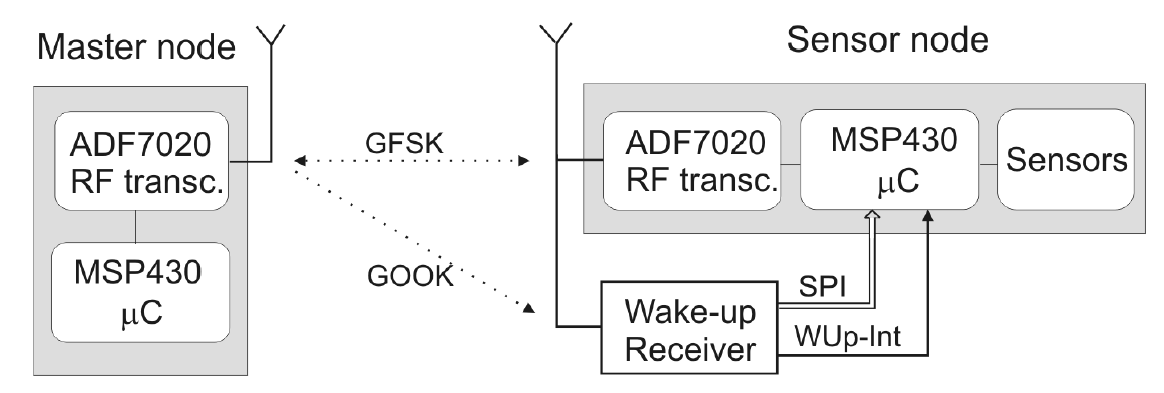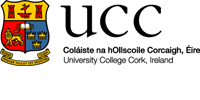Nanowatt wake-up receiver for ultra-low power RF devices
| Start date | July 2012 |
|
| Client | University College Cork | |
| Investigator |
Dr David Nugent |
Abstract
Researchers at University College Cork have developed a nanowatt wake-up receiver (WUR) for use in ultra low power devices such as implanted medical devices. Consuming barely a fifth of established WUR solutions, the UCC technology will improve the battery lifetime of associated microprocessors whilst enabling perpetual sensing applications through energy harvesting. A patent has been filed and UCC is seeking exploitation partners such as wireless transceiver and medical implant vendors.
Technology
The receiver architecture is based on an envelope detector, used for the
OOK demodulation. A
charge pump (two-stage voltage doubler-multiplier) is used as an OOK signal
envelope detector, and the demodulated signal fed to a data slicer, which
raises the demodulated digital signal to voltage levels that can be used
by later digital circuitry. The comparator threshold is adaptive, rather
than constant, and is determined by the wake-up signal strength. This digital
signal is then classified using passive circuitry to detect the “intended”
wake up signal and to reject random toggling due to noise or nearby wireless
communications. Classification is done by detecting the wake-up preamble
if it is generated at the expected OOK data rate range.
The next part of the circuit is a Pulse-Width Modulation (PWM) decoder and SPI adapter. This part of the circuit first decodes the PWM encoded signal and generates SPI compatible signals for data transfer to the processor. The architecture is power efficient since most components constituting it are passive. The only active components are the data slicer (comparator) and the SPI adapter. Due to the simplicity of this circuit, the power consumption is kept very low.
The basic functionality is achieved by using an envelope detector as a simple and low power wireless receiver, and building simple active circuitry around it to raise the voltage levels, reject false wake up signals, and make the output SPI compatible.

Specifications
Power consumption: Operating at 434 MHz the measured power consumption is only 270nW. This is barely 20 percent of specialist ULP devices such as the Zarlink ZL70102 (2.45 GHz) and Texas Instruments CC1100E (868 MHz), and over 100 times less than consumer standards such as Bluetooth and Zigbee. An ASIC implementation will further reduce parasitic capacitances and thereby power consumption.
Availability: The UCC receiver operates in an always-on state. This is unlike contemporary schemes where the WUR itself is woken periodically by a separate strobe pulse. As tabulated below, these strobe pulses consume more current than the WUR itself, representing a major source of power consumption in implanted devices. An additional issue with strobing is that the frequency of the low-power RC oscillator used for the WOR functionality varies with temperature and supply voltage. To keep the frequency as accurate as possible, the RC circuit is calibrated periodically by the crystal oscillator. By comparison, the UCC technology operates in an always-on state, thereby eliminating the costs and current drain of the strobe pulses.
Frequency: The operating frequency is easily changed by a few discrete components. UCC researchers have tested from 27 MHz up to 2.45 GHz. Unlike conventional techniques employed in implanted medical devices, where a dedicated 2.45 GHz antenna is required for the wake-up circuit, the UCC implementation can share the RF data link antenna thereby cutting costs and space requirements.
Modulation scheme: On-off-key (OOK) modulation is employed since it avoids the need for a local oscillator and synthesizer in the receiver.
Coding scheme: The UCC design can support a variety of coding schemes including Manchester, Pulse Internal Encoding, and Pulse Width Modulation. PWM is preferred in order to have very low power clock/data extraction and conversion to an SPI compatible interface.
| Vendor | Zarlink |
Zarlink |
TI |
UCC |
| Device | ZL0101 |
ZL70102 |
CC1100E |
Lab
demo |
| Data released | Nov-2006 |
Jun-2010 |
Apr-2009 |
Sep-2011 |
| Test mode | Measured |
Specified |
Specified |
Measured |
| WUR frequency | 2.45 GHz |
2.45 GHz |
868 MHz |
434MHz |
| Modulation scheme | OOK |
OOK |
Not specified |
OOK |
| Coding scheme | Manchester |
Not specified |
Not specified |
Pulse
width modulation |
| Wake-up pulse duration | 240us |
240us |
Not specified |
Always
on |
| Strobe frequency | 1.15 secs |
Not specified |
Not specified |
Always
on |
| Idle current drain | 10nA |
Not specified |
Not specified |
Always
on |
| Active WUR current | 715uA |
Not specified |
Not specified |
Always
on |
| Average WUR current | 159nA |
290nA |
300nA |
135nA |
| Strobe current | <400nA |
<400nA |
400nA |
Always
on |
| Total current | 559nA |
690nA |
700nA |
135nA |
| Min operating voltage | 2.0V |
2.0V |
1.8V |
2.0V |
| Power consumption | 1,118nW |
1,380nW |
1,260nW |
270nW |
| Data source |
Documents available for download
Access to the following documents may require subscription to the relevant publication.
| Marinkovic, S.J.; Popovici, E.M., "Ultra Low Power Signal Oriented Approach for Wireless Health Monitoring", Sensors 2012, 12(6), 7917-7937 | |
| Marinkovic, S.J.; Popovici, E.M., "Power efficient networking using a novel wake-up radio," Pervasive Computing Technologies for Healthcare (PervasiveHealth), 2011 5th International Conference on , vol., no., pp.139-143, 23-26 May 2011 | |
| Marinkovic, S.J.; Popovici, E.M.; , "Nano-Power Wireless Wake-Up Receiver With Serial Peripheral Interface," Selected Areas in Communications, IEEE Journal on , vol.29, no.8, pp.1641-1647, September 2011 | |
| Marinkovic, S.J.; Popovici, E.M.; Spagnol, C.; Faul, S.; Marnane, W.P.; , "Energy-Efficient Low Duty Cycle MAC Protocol for Wireless Body Area Networks," Information Technology in Biomedicine, IEEE Transactions on , vol.13, no.6, pp.915-925, Nov. 2009 | |
| "Low Power Wake-Up System and Method for Wireless Body Area Networks", WIPO Patent Application WO/2012/010676 |

